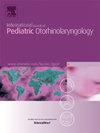儿童睡眠呼吸障碍联合腺样体切除术和激光扁桃体切除术后的生活质量:一项前瞻性观察队列试验
IF 1.2
4区 医学
Q3 OTORHINOLARYNGOLOGY
International journal of pediatric otorhinolaryngology
Pub Date : 2025-05-21
DOI:10.1016/j.ijporl.2025.112402
引用次数: 0
摘要
扁桃体切开术是儿童睡眠呼吸障碍(PSDB)扁桃体手术的一种替代扁桃体切除术,其发病率低得多,但符合其有效性的扁桃体疾病特异性生活质量数据较少。方法对行激光扁桃体切开术的PSDB患儿进行前瞻性观察研究。术前(T0)、术后3个月(T3)和术后6个月(T6)分别测量儿童(G-TAHSI-c)、家长(G-TAHSI-p)和扁桃体切除术结局量表14 (TOI-14)的德文版本扁桃体和腺样体健康状况仪(TAHSI)。结果儿童54例,其中男性占65%;中位年龄:4岁;96.3%为联合腺扁桃体切开术。T0和T3期间g - tasi -c子域进食/吞咽、口臭、工作表现和总分均有显著改善(p <;0.05)。反复咽部感染、慢性咽部感染、淋巴结病、健康利用和夜间呼吸亚域无显著变化(p >;0.05)。g - tahsip亚域包括慢性咽喉感染、进食和吞咽问题、口臭、严重咽喉感染和总体g - tahsip改善(所有p <;0.05)。除TOI-14子域社会心理限制和总分外,其他子域从T0到T3均有显著提高(p <;0.05)。T3和T6之间g - tasci -c、g - tasci -p和TOI-14没有明显的进一步变化(所有p >;0.05)。性别、年龄、初始OSA-18评分对生活质量改善无影响。结论(腺)扁桃体切除术可在术后3个月内快速改善PSDB患儿的生活质量。本文章由计算机程序翻译,如有差异,请以英文原文为准。
Quality of life after combined adenoidectomy and laser tonsillotomy for pediatric sleep-disordered breathing: A prospective observational cohort trial
Introduction
Tonsillotomy is an alternative to tonsillectomy with much less morbidity in case of tonsil surgery for pediatric sleep-disordered breathing (PSDB), but tonsillar disease-specific quality of life data conforming the effectiveness are sparse.
Methods
A prospective observation study was conducted in children with PSDB undergoing laser (adeno)tonsillotomy. A German version Tonsil and Adenoid Health Status Instrument (TAHSI) for the children (G-TAHSI-c), for the parents (G-TAHSI-p), and the Tonsillectomy Outcome Inventory 14 (TOI-14) were measured before surgery (T0), 3 months (T3), and 6 months (T6) after surgery.
Results
54 children (65 % male; median age: 4 years; 96.3 % combined adenotonsillotomy) were included. The G-TAHSI-c subdomains eating/swallowing, halitosis, work performance, and the total score improved significantly between T0 and T3 (all p < 0.05). The subdomains recurrent throat infections, chronic throat infections, lymphadenopathy, health utilization, and nocturnal breathing did not change significantly (all p > 0.05). The G-TAHSI-p subdomains chronic throat infections, eating and swallowing problems, halitosis, severe throat infections, and the total G-TAHSI-p improved (all p < 0.05). All subdomains but the TOI-14 subdomain social psychological restrictions and the total score improved significantly from T0 to T3 (all p < 0.05). A significant further change between T3 and T6 was not seen for G-TAHSI-c, G-TAHSI-p, and TOI-14 (all p > 0.05). Gender, age, and initial OSA-18 score had no influence on the quality of life improvement.
Conclusions
(Adeno)tonsillotomy leads to fast quality of life improvement in children with PSDB within 3 months after surgery.
求助全文
通过发布文献求助,成功后即可免费获取论文全文。
去求助
来源期刊
CiteScore
3.20
自引率
6.70%
发文量
276
审稿时长
62 days
期刊介绍:
The purpose of the International Journal of Pediatric Otorhinolaryngology is to concentrate and disseminate information concerning prevention, cure and care of otorhinolaryngological disorders in infants and children due to developmental, degenerative, infectious, neoplastic, traumatic, social, psychiatric and economic causes. The Journal provides a medium for clinical and basic contributions in all of the areas of pediatric otorhinolaryngology. This includes medical and surgical otology, bronchoesophagology, laryngology, rhinology, diseases of the head and neck, and disorders of communication, including voice, speech and language disorders.

 求助内容:
求助内容: 应助结果提醒方式:
应助结果提醒方式:


